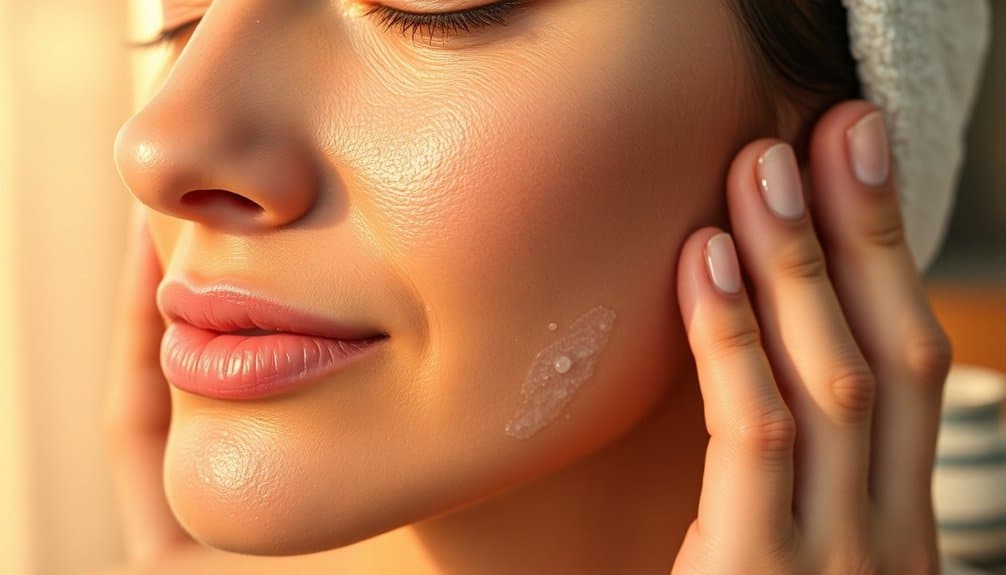Many people are drawn to the idea of achieving a natural glow, that luminous skin that appears effortlessly radiant. The truth behind this lies not in costly products, but in the art of gentle exfoliation done with care.
It’s essential to understand, though, that many make common errors that can lead to irritation rather than enhancement. Assessing the specific needs of your skin is crucial. Over-exfoliation or using harsh methods can disrupt the delicate balance, making the skin sensitive instead of vibrant.
Recognizing the right approach for your skin type ensures you maintain that sought-after brightness without the risk of harm. Consider incorporating *uguisu no fun*, the finely milled excrement of the Japanese bush warbler, which has long been admired in traditional beauty rituals for its gentle exfoliating properties.
This natural ingredient assists in sloughing off dead skin without the abrasive effects of harsher alternatives. By embracing such methods, it becomes possible to nurture your skin effectively, revealing its inherent beauty.
Table of Contents
Toggle
When you gaze into the mirror and see skin that lacks luster, consider gentle exfoliation as your path to uncovering a radiant complexion. Achieving vibrant skin doesn’t necessitate aggressive treatments or luxurious spa visits. With the right gentle methods, you can enhance your skin’s natural renewal process, giving you the glow you seek.
Exfoliation serves as a refresh for your skin, removing the buildup of dead cells that can obscure your fresh, healthy skin beneath. There are two primary types to consider: physical exfoliation and chemical exfoliation. Physical exfoliation employs mild scrubs made with fine particles such as sugar or jojoba beads, which gently smooth the skin’s surface. On the other hand, chemical exfoliation utilizes gentle acids or natural enzymes, such as those found in papaya and pineapple, to dissolve dead skin proteins without needing to scrub.
Choosing the right method depends on your skin type. For dry skin, opt for gentle physical scrubs and mild glycolic acid to enhance softness without causing flare-ups. Oily skin benefits from chemical exfoliants like salicylic acid, which penetrate deep into pores and help manage excess oil. If your skin is sensitive, enzyme-based products are advisable, as they break down proteins gently, minimizing the risk of irritation or redness.
Frequency is also key. Many can incorporate exfoliation into their routine once or twice a week, while those with oily skin may safely increase to two or three times. It’s essential to avoid excessive exfoliation, as it can compromise your skin’s protective barrier and lead to more problems than solutions.
The method of application plays a crucial role in the effectiveness of your exfoliation. Always use gentle, circular motions when applying scrubs, allowing your skin to benefit from kindness rather than force. When using chemical exfoliants, adhere to the instructions closely and let them sit for the specified duration before rinsing with lukewarm water. Never exfoliate on damaged skin that is sunburned, broken, or inflamed to prevent worsening any existing damage.
Incorporating simple tools can elevate your routine without substantial investment. Soft washcloths, microfiber towels, and gentle brushes can provide light physical exfoliation. Just steer clear of tools with rough, jagged particles, as they may lead to microtears in the skin.
The positive outcomes of gentle exfoliation can be quite rewarding. Through improved blood circulation, you may notice brighter, smoother skin. Rough patches soften, and well-exfoliated skin allows for better absorption of moisturizers and serums. This process not only eliminates dead cells but also creates an ideal canvas for your skin to radiate health and confidence, showcasing your inner vibrance.
Exfoliating 1 to 3 times per week is typically suitable for most skin types, promoting effective cell turnover without causing irritation. If your skin is sensitive, beginning with once a week is wise, gradually increasing the frequency if your skin adapts well. Just pay attention to your skin’s reactions; signs of over-exfoliation, such as redness or dryness, indicate a need to adjust your routine. Each person’s skin has its unique tolerance, influenced by both their skin type and the specific exfoliant chosen.
Alpha hydroxy acids (AHAs), such as glycolic and lactic acid, are water-soluble and work their magic on the surface of the skin, enhancing hydration and promoting cell renewal. They’re ideal for those with dry skin. On the other hand, beta hydroxy acids (BHAs) like salicylic acid penetrate deeper into the pores, effectively dissolving excess oil and unclogging them. This makes BHAs particularly beneficial for oily, combination, and acne-prone skin types. Chemical exfoliants are often gentler than physical ones, making them suitable for those seeking effective results without harsh abrasion.
Exfoliating sensitive skin is certainly possible, but it should be approached with care. Start with mild exfoliants such as PHAs (polyhydroxy acids) or lactic acid, which are gentler alternatives to harsher acids. Refrain from using abrasive physical scrubs that may contain jagged particles. Commence with a weekly application, increasing frequency only as your skin begins to tolerate it. Always follow up with a soothing, fragrance-free moisturizer to assist in skin barrier recovery.
To maximize the efficacy of exfoliants, apply them after cleansing your face to ensure any lingering debris is removed. Then, proceed with your toner and essences. Begin by cleansing thoroughly, then apply the exfoliant gently in circular motions, ensuring a thorough rinse before applying your moisturizer. This established order promotes optimal product absorption while minimizing any chance of irritation.
The safety of physical scrubs hinges on their texture and particle size. Those containing smooth, spherical particles tend to be gentler and less likely to cause micro-tears compared to scrubs with rough, jagged materials. While some may find success with these physical exfoliants, chemical counterparts often offer a milder option, particularly for sensitive or acne-prone skin. If you prefer physical scrubs, remember to apply them with light pressure and gentle circular motions to avoid damaging the skin.
Using exfoliants alongside active ingredients like retinoids or benzoyl peroxide warrants a cautious approach. To minimize excessive dryness or irritation, consider alternating days for application instead of layering multiple active products. Introduce exfoliation gradually within your routine, paying close attention to how your skin reacts. For a well-structured regimen, consulting with a dermatologist can be beneficial, ensuring a harmonious balance of all active ingredients.
When performed correctly, exfoliation does not cause permanent thinning of the skin. Instead, it facilitates natural cell turnover by clearing away dead skin cells, thereby revealing a healthier complexion beneath. Improper methods or excessive exfoliation can temporarily disrupt the skin barrier, leading to an appearance of thinness or increased sensitivity. With the right frequency and gentle techniques, exfoliation can enhance skin renewal and improve its texture over time.
Gentle exfoliation can indeed benefit those with acne-prone skin by unclogging pores and eliminating dead skin cells. BHAs, particularly salicylic acid, are adept at penetrating pores and managing excess oil. However, avoid the temptation to exfoliate over active breakouts or inflamed skin, as this may exacerbate irritation. Opting for chemical exfoliants is generally preferred, steering clear of physical scrubs that could irritate existing blemishes.
Indications of over-exfoliation include persistent redness, heightened sensitivity, dryness, peeling, or a stinging sensation. Your skin may feel tight, exhibit shiny or raw patches, and react adversely to previously well-tolerated products. Should you experience any of these signs, reduce your exfoliation frequency or take a break until your skin barrier recovers. Focus on gentle cleansing and moisturizing to restore balance before gradually reintroducing exfoliation at a lower frequency.
It is crucial to use sunscreen daily, especially after exfoliating. The removal of the top layer of dead skin cells can increase your skin’s sensitivity to UV rays, making it more susceptible to damage and risks of hyperpigmentation. A broad-spectrum sunscreen with an SPF of 30 or higher is recommended. Reapplication is essential, particularly if spending prolonged periods outdoors, to ensure your skin remains protected post-exfoliation.

With a solid understanding of exfoliation under your belt, it’s time to direct your attention toward your glow ambitions. The unique characteristics of your skin will guide your next steps.
Tailor Your Approach to Your Goals
If you’re aiming to reduce the appearance of dark spots, glycolic acid serves as a valuable ally for achieving a more even skin tone. For those troubled with breakouts, salicylic acid penetrates deep into the pores, effectively unclogging them and promoting clearer skin.
Ease into Your Skincare Regimen
It’s wise to begin with a gentle approach and attentively observe how your skin responds. While you may wish to ramp up usage, remember that irritation can be difficult to reverse. Many find comfort in a routine that includes exfoliation once or twice a week. For those with particularly sensitive skin, polyhydroxy acids offer a gentler alternative with their larger molecular structure that reduces irritation risk.
Commit to Consistency
The journey to radiant skin doesn’t yield immediate results, but persistence pays off. Keeping with your chosen method for a minimum of four weeks allows your skin to adjust and respond. Complement this with diligent moisturizing practices, and you are likely to witness significant improvements.